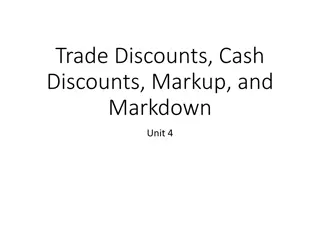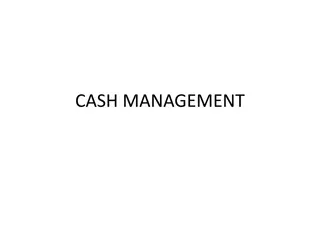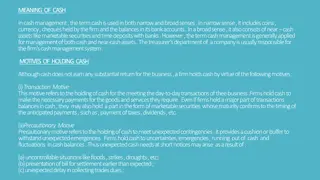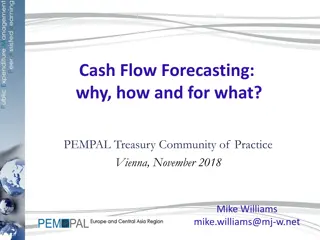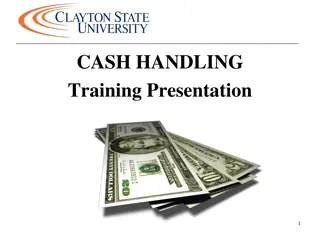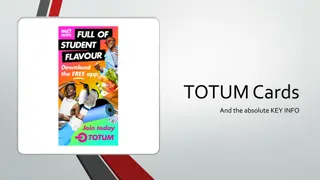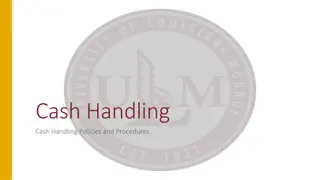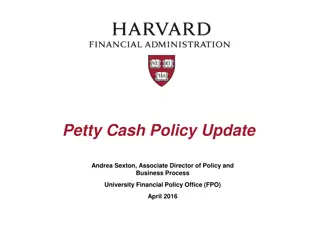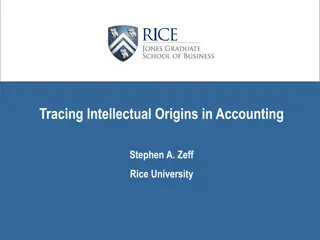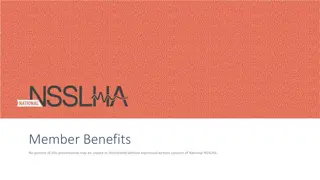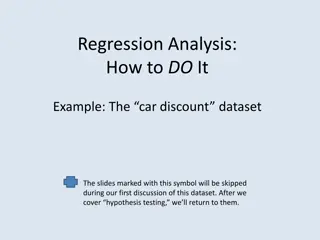Understanding Trade and Cash Discounts in Accounting
Trade and cash discounts are types of rebates offered on purchased goods to customers. Trade discounts are given based on the quantity or amount purchased and are not recorded in accounting books, while cash discounts are given to encourage prompt payments and are separately recorded. Examples illustrate how trade and cash discounts are applied in transactions, impacting the net value and amount paid for goods.
Download Presentation

Please find below an Image/Link to download the presentation.
The content on the website is provided AS IS for your information and personal use only. It may not be sold, licensed, or shared on other websites without obtaining consent from the author. Download presentation by click this link. If you encounter any issues during the download, it is possible that the publisher has removed the file from their server.
E N D
Presentation Transcript
DISCOUNT: Discount is the rebate allowed or received on the value of good souls or purchased. A discount may be classified into two categories : 1. Trade discount 2. Cash discount 1.Trade discount: Trade discount is the allowance may to a customer if he is purchasing goods of certain quantity or amounts. The discount so allowed is red tale value and sale purchase is recorded in the books at the net value i.e. net of trade discount. Trade discount is not allowed in the books of account. 2.Cash discount: A cash discount is allowance to encourage from payments of the amount due. Cash discount received or allowed is recorded separately in the books of account. A cash discount is allowed when payment is received when a payment is made. The cash discount allowed is debited to the discount allowed account and the discount received is credited to the discount received account . Example: Purchased goods from Michael worth 40,000 at term 10% trade discount and 5% cash discount paid amount at the time of purchase itself.
Example: Purchased goods from Vijay 40,000 on 10% trade discount and 5% cash discount paid amount at the time of purchase itself. Invoice price of goods = 40,000 Trade discount@ 10% = 4,000 = 36,000 (40,000 4,000) Less cash discount@5% = 2,800 Amount paid= 34,200 (36,000 2,800)
Purchased goods from Vijay worth 40,000 on 10% trade discount and 5% cash discount and half of the amount paid at the time of purchase . Invoice price of goods = 40,000 Less trade discount@10% = 4,000 Net value of goods = 36,000 (40,000 4,000 ) i. Credit transaction = 18,000 ii. Cash transaction = 18,000 Less cash discount@5% = 900 Amount paid = 17,100 ( 18,000 900) DATE DATE PARTICULARS PARTICULARS L.F. L.F. DEBIT (Rs.) DEBIT (Rs.) Dr. Dr. CREDIT (Rs.) CR. CREDIT (Rs.) CR. Purchase a/c Dr. 36,000 To Vijay 18,000 To Cash a/c 17,100 To Discount a/c 900
Purchase goods at the list price of rupees 25000 from Mohan on 20% Trade discount and 2% cash discount and paid 40% of the amount at the time of purchase. Invoice price of goods = 25,000 Less trade discount@20% = 5,000 Net value of goods = 20,000 ( 25,000 5,000) i. Credit transaction = 12,000 ii. Cash transaction = 8,000 Less cash discount@2% = 160 Amount paid = Rs . 7,840 ( 8,000 -160) DATE DATE PARTICULARS PARTICULARS L.F. L.F. DEBIT (Rs.) DEBIT (Rs.) Dr. Dr. CREDIT (Rs.) Cr. CREDIT (Rs.) Cr. Purchase a/c Dr. 20,000 To Mohan 12,000 To Cash a/c 7,840 To Discount a/c 160
Sales: Example: Sold goods to Anil for rupees 20000 allowed him 10% trade discount and 10% cash discount received half of the amount by cash and balance half by check within a specified period. Invoice price of goods = 20,000 Less trade discount allowed @10% percent = 2,000 Amount = 18,000 ( 20,000 2,000) Half amount (credit) = 9,000 Half amount (cash) = 9,000 Less cash discount allowed @10% = 900 Amount paid = Rs . 8,100 ( 9,000 900) DATE DATE PARTICULARS PARTICULARS L.F. L.F. DEBIT (Rs.) DEBIT (Rs.) Dr. Dr. CREDIT (Rs.) Cr. CREDIT (Rs.) Cr. Bank a/c Dr. 9,000 Cash a/c Dr. 8,100 Discount a/c Dr. 900 To sales a/c 18,000
Example: Sold goods to Ajay for Rs .50,000 at 10% trade discount and 5% cash discount half amount received by cheque with in specifiedtime. Invoice price of goods = 50,000 Less trade discount allowed@10% = 5,000 Amount = 45,000 (50,000 5,000) Half amount received by cheque (credit transaction) = 22,500 Cash transaction = 22,500 Less cash discount allowed@10% = 1,125 Amount paid = Rs. 21,375 ( 22,500 1,125 ) DATE DATE PARTICULARS PARTICULARS L.F. L.F. DEBIT(Rs.) DEBIT(Rs.) Dr. Dr. CREDIT (Rs.) Cr. CREDIT (Rs.) Cr. Cash a/c 21,375 Discount allowed a/c 1,125 Bank a/c 22,500 To Sales a/c 45,000
SPECIAL TRANSACTIONS 1. 1.Goods given as charity : Goods given as charity : The amount of purchase reduced with the value of goods given at charity; purchases are reduced because goods are used for purposes other than sale. The entry will be: Charity A/c Dr. To Purchase A/c2 2. 2. Good distributed as free sample : Good distributed as free sample : To increase sales sometimes goods are distributed as free samples. It is the part of the advertisement expenses and hence is debited to advertisement account and reduced from purchases by crediting purchase account. The entries will be: Advertisement A/c Dr. To Purchase A/c 3 3. . Goods lost by theft or fire : Goods lost by theft or fire : In both the cases it is loss of goods and loss of business. Entries will be : Loss by theft or fire a/c Dr. To purchase a/c
Sundry Expenses : Sundry Expenses : Often petty expenses such as for refreshment, postage, convenience encuredin a business . It is not desirable to record such expenses in a separate account of each expenses. These expenses are generally debited in one account i.e. sundry expenses account . The journal entries will be: Sundry/Miscellaneous a/c Dr. To Cash a/c Outstanding Expenses : Outstanding Expenses : Outstanding expenses are the expenses that relate to the current year but have not been paid till the year end. ( liabilitiestobusiness ).The entries will be: Particular expenses a/c Dr. To Outstanding Expenses a/c
Prepaid or unexpired expenses: Prepaid or unexpired expenses: ( Assets to business ) Expenses paid in advance are called prepaid expenses . The entries will be : Prepaid expenses a/c Dr. To Expenses a/c Income and but not received Income and but not received : (Accrued Income) ( Assets of the firm ) The income which has been earned but not received is called accrued income . The entries will be : Accrued Income a/c Dr. To Income a/c Income received in advance or Unearned income : Income received in advance or Unearned income : ( Liability to the business ) Income received but not earned during accounting period is called unearned income . Then the journal entry will be : Particular Income a/c Dr. To Income received in advance a/c


